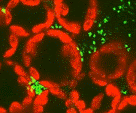Plant Pathology Department
Document Type
Article
Date of this Version
5-1-1995
Abstract
In the United States, a country with food in great abundance, it is difficult to realize that, were it not for the current level of plant disease and pest management, most human resources would be needed to obtain enough food and other plant and animal products merely to survive. Instead, there are surpluses, markets for many agricultural products are depressed, and funds available for research on plant disease and pest management-and for agricultural research generally-have plateaud or are declining.
Why does the United States need more research on plant disease and pest management? Because the health and productivity of the crops and cropping systems upon which the people depend for their own consumption and for export cannot be sustained without continuing research and development. This continued investment is needed to manage ever threatening, changing, and rebounding diseases and pest populations. Moreover, disease and pest management of the future must be improved while simultaneously reducing our dependence on pesticides as one of many steps toward the goal of sustainable agriculture.
The goal of plant disease and pest management is to ensure that crops are healthy enough to yield to their full genetic potential within the physical limits imposed by the uncontrolled variables of climate, weather, and soils. Management is defined as limiting damage from diseases or pests to a level at or below an acceptable economic or aesthetic threshold. This process does not require total elimination or eradication of the pest or disease problem.
Reducing the use of pesticides is a desirable goal, but it depends on continued and increased investments in research on alternatives. For many chemical pesticides, the alternatives either are not yet developed or are less effective than chemicals. This research must be broadly based across the biological, physical, and social sciences. Moreover, the United States and the world depend not only on sustainable agriculture but also on sustainable growth in agriculture to meet a long-term increase in demand for quality and quantity of agricultural products expected from increases in both numbers and economic status of people (Rutan 1992). Furthermore. these increases must 'be attained at the same time that available agricultural land is decreasing to satisfy other needs such as more land for recreation and urbanization; restoration of some wetlands, grasslands, and woodlands; and diversions of land from farming to other uses. Improved disease and pest management offers one of the few effective means by which the necessary increases in crop productivity can be accomplished while natural resources, including the remaining forests, are protected. These same principles apply to other uses of plants as well, including as ornamentals, for landscapes, and in parks and golf courses.



Comments
Published in BioScience Vol. 45 No. 5. Copyright 1995. Used by permission.